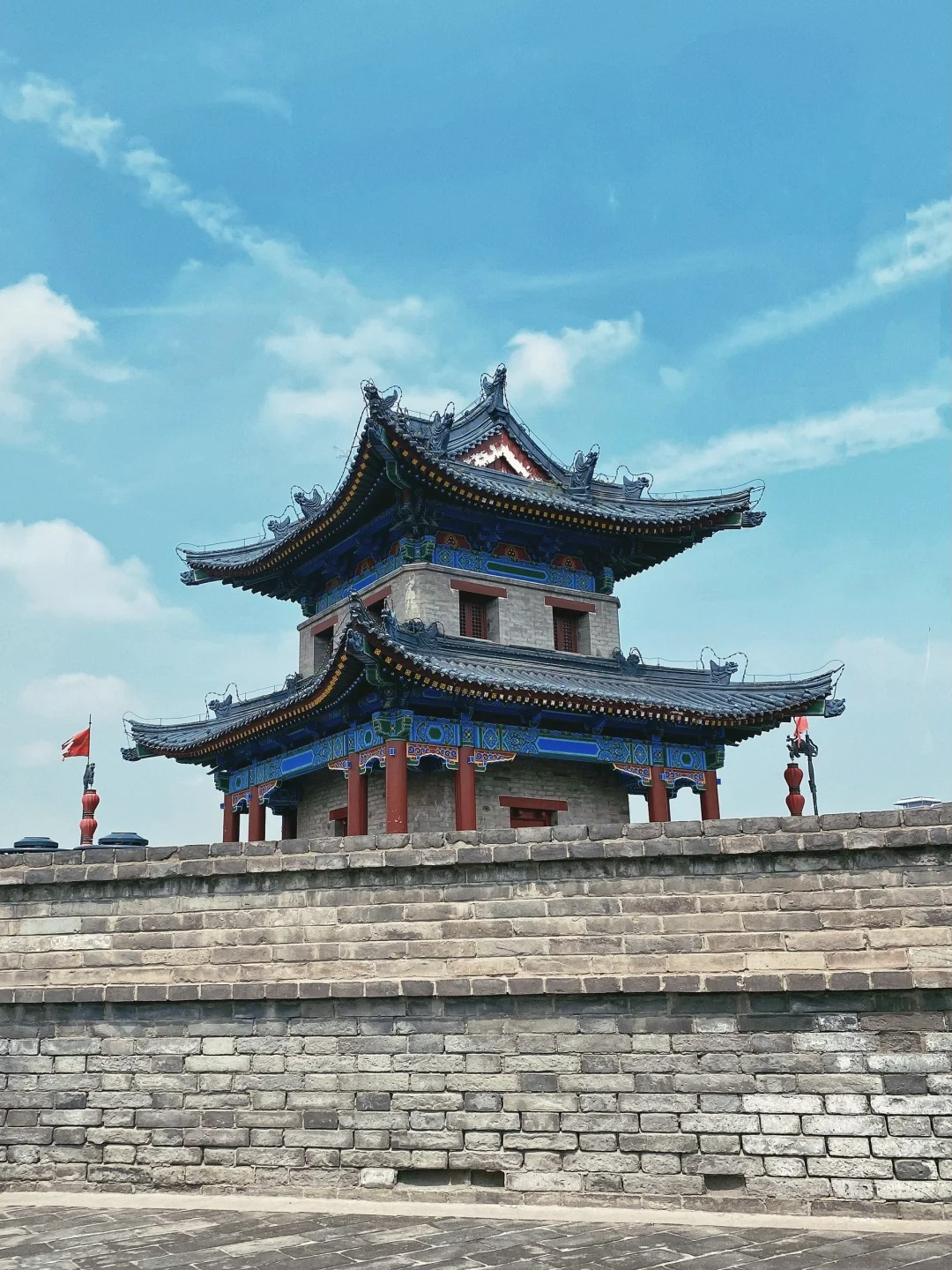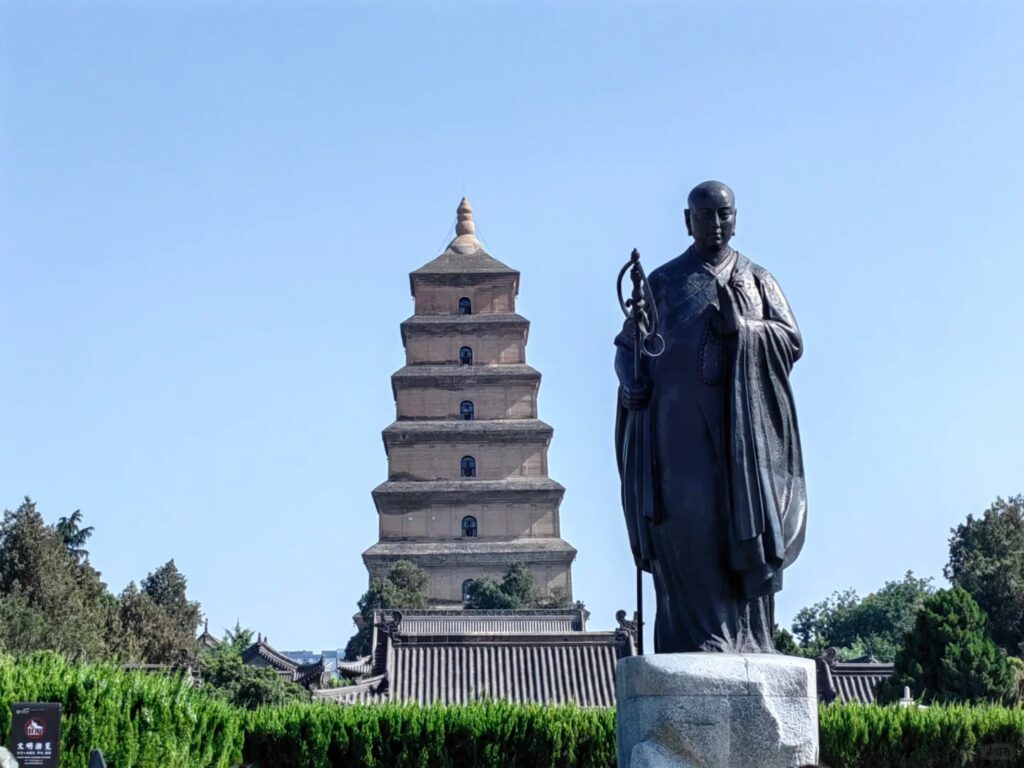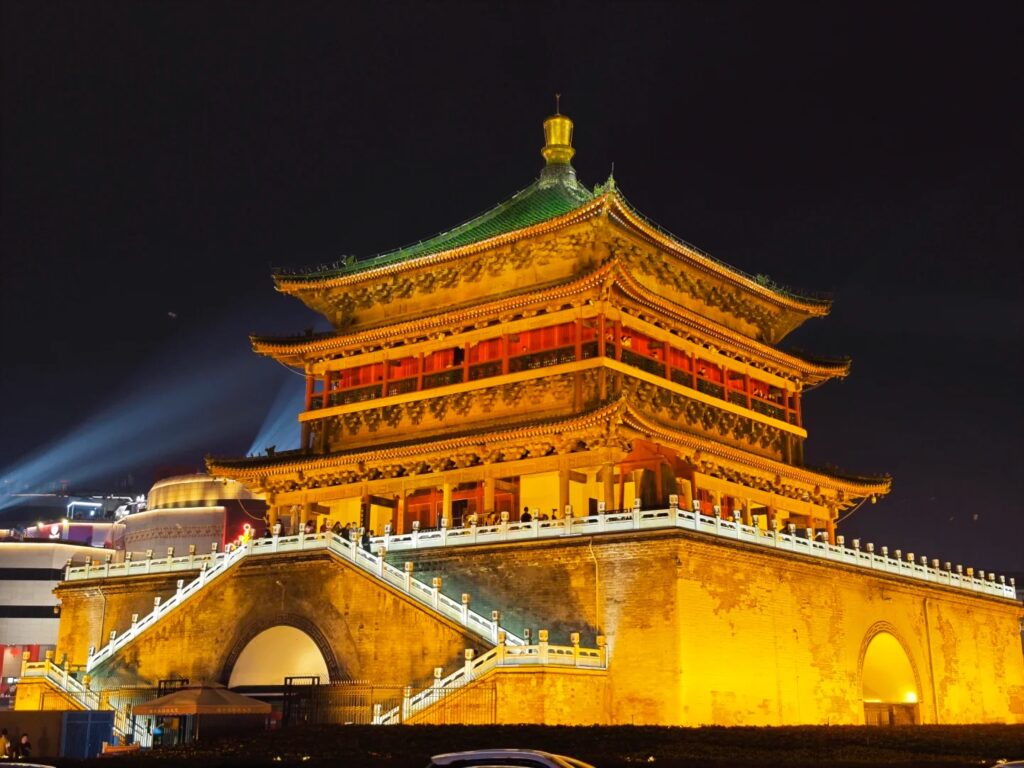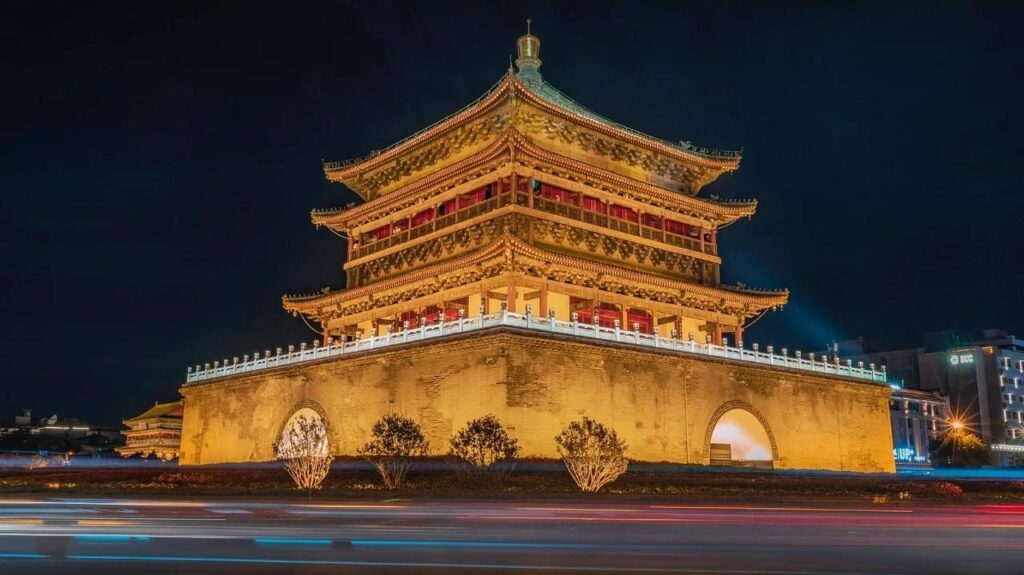Visiting Information
| Information | Details |
|---|---|
| Chinese Name | 西安城墙 (Xī’ān Chéngqiáng) |
| Location and Address | South Section: 2 Shuncheng E Alley, Xincheng District, Xi’an, Shaanxi, China |
| Opening Time/Hours | 8:00 AM – 10:00 PM (March to November) 8:00 AM – 7:00 PM (December to February) |
| Entrance Fee | 54 CNY for adults 27 CNY for students and seniors (with valid ID) |
| How to Get There | By Metro: Line 2 to Yongningmen Station (South Gate) By Bus: Lines 6, 11, 12, 23, 201, 206, 208, 216, 218, 221, 222, 229, 251, 300, 600, 604, 611, K630 to South Gate By Taxi: Tell the driver “Xi’an Chengqiang” or show the Chinese characters 西安城墙 |
| Best Time for Visit | March to May and September to November for pleasant weather |
| Contact Info | Phone: +86 29 8726 1374 Email: [email protected] |
Overview
The Xi’an City Wall, also known as the Fortifications of Xi’an, is one of the oldest, largest, and best-preserved city walls in China. Enclosing the old city of Xi’an in Shaanxi province, this impressive structure stretches over 13.7 kilometers in length, forming a rectangle around the city center. Built during the Ming Dynasty, the wall stands as a testament to ancient Chinese architecture and military defense systems, offering visitors a unique glimpse into China’s rich history and cultural heritage.
Historical Background
The Xi’an City Wall was originally built in 194 BCE during the Han Dynasty, but the current structure dates back to 1370 CE when it was rebuilt and expanded under the Ming Dynasty. The wall was constructed as part of Emperor Zhu Yuanzhang’s military defense strategy, designed to protect the imperial capital of Xi’an. Over the centuries, the wall has witnessed numerous historical events and served various purposes, from military defense to flood control. Despite facing threats of demolition in the 20th century, preservation efforts have ensured that the wall remains a prominent feature of Xi’an’s urban landscape, connecting the city’s ancient past with its modern present.

Architectural Features
- Wall Structure: The Xi’an City Wall is a massive earthen core wrapped in layers of brick and stone. It stands 12 meters high, 12-14 meters wide at the top, and 15-18 meters thick at the base. This robust construction has allowed the wall to withstand centuries of weathering and warfare. The top of the wall is paved with bricks, creating a walkway that allows visitors to stroll or cycle around the entire perimeter of the old city.
- Gates and Towers: The wall features four main gates, one in each cardinal direction: Changle (East), Anding (West), Yongning (South), and Anyuan (North). Each gate is topped with intricate towers built in traditional Chinese architectural style. These gate towers, along with several corner towers and watchtowers along the wall, served both defensive and decorative purposes. The towers are multi-tiered structures with elaborate roofs, providing excellent vantage points for surveillance and defense in ancient times.
- Moat and Drawbridges: Surrounding the outer perimeter of the wall is a wide moat, which added an extra layer of defense to the city. Originally, the moat was filled with water and could only be crossed via drawbridges at each of the main gates. Today, while the moat is mostly dry, it still contributes to the impressive appearance of the fortification. Some sections of the moat have been restored and filled with water, enhancing the historical ambiance.
- Ramparts and Battlements: The top of the wall is equipped with crenellated battlements, providing cover for defenders. These battlements, along with the rampart walkways, allowed soldiers to move quickly along the wall and respond to threats from any direction. The inner side of the wall features a series of ramps and staircases that facilitated the movement of troops and supplies to the top of the wall.
Cultural Importance
The Xi’an City Wall holds immense cultural significance as a symbol of China’s ancient urban planning and military architecture. It represents the power and grandeur of imperial China, particularly during the Ming Dynasty. The wall has been a silent witness to Xi’an’s transformation from an ancient capital to a modern city, bridging the gap between past and present. It serves as a tangible link to Xi’an’s role as the starting point of the Silk Road and its status as one of the Four Great Ancient Capitals of China. Today, the wall is not just a historical relic but a living part of Xi’an’s cultural landscape, hosting various events and festivals that celebrate local traditions and history. Its preservation and continued use demonstrate China’s commitment to protecting its cultural heritage while adapting to modern urban needs.
Surrounding Attractions
- Bell Tower and Drum Tower: Located in the heart of Xi’an, these iconic towers are visible from the City Wall. The Bell Tower, dating back to 1384, stands at the geographical center of the ancient capital. The Drum Tower, built in 1380, is situated to the northwest of the Bell Tower. Both towers served important timekeeping functions in ancient times and now offer visitors a glimpse into traditional Chinese architecture and culture. Climbing these towers provides panoramic views of the city and the surrounding City Wall.
- Muslim Quarter: Just north of the Drum Tower lies Xi’an’s famous Muslim Quarter, a bustling area filled with narrow streets, traditional architecture, and countless food stalls. This neighborhood has been home to the city’s Hui Muslim community for centuries. Visitors can explore the Great Mosque, one of the oldest and largest mosques in China, sample local delicacies like Roujiamo (Chinese hamburger) and Yangrou Paomo (mutton soup with bread), and shop for souvenirs in the lively bazaars.
- Shaanxi History Museum: Located just outside the south gate of the City Wall, this museum is one of China’s premier museums. It houses over 370,000 artifacts that span the long history of Shaanxi Province, including treasures from the Zhou, Qin, Han, and Tang dynasties. The museum’s collection includes bronze wares, pottery figures, and gold and silver objects, providing a comprehensive overview of Chinese civilization from prehistoric times to the modern era.
- Big Wild Goose Pagoda: This iconic Buddhist pagoda, located about 4 kilometers south of the City Wall, was built in 652 during the Tang Dynasty. Originally constructed to house Buddhist sutras brought back from India by the monk Xuanzang, it now stands as a symbol of Xi’an’s rich Buddhist heritage. Visitors can climb the pagoda for views of the city, explore the surrounding Da Ci’en Temple complex, and enjoy the nightly musical fountain show in the North Square.
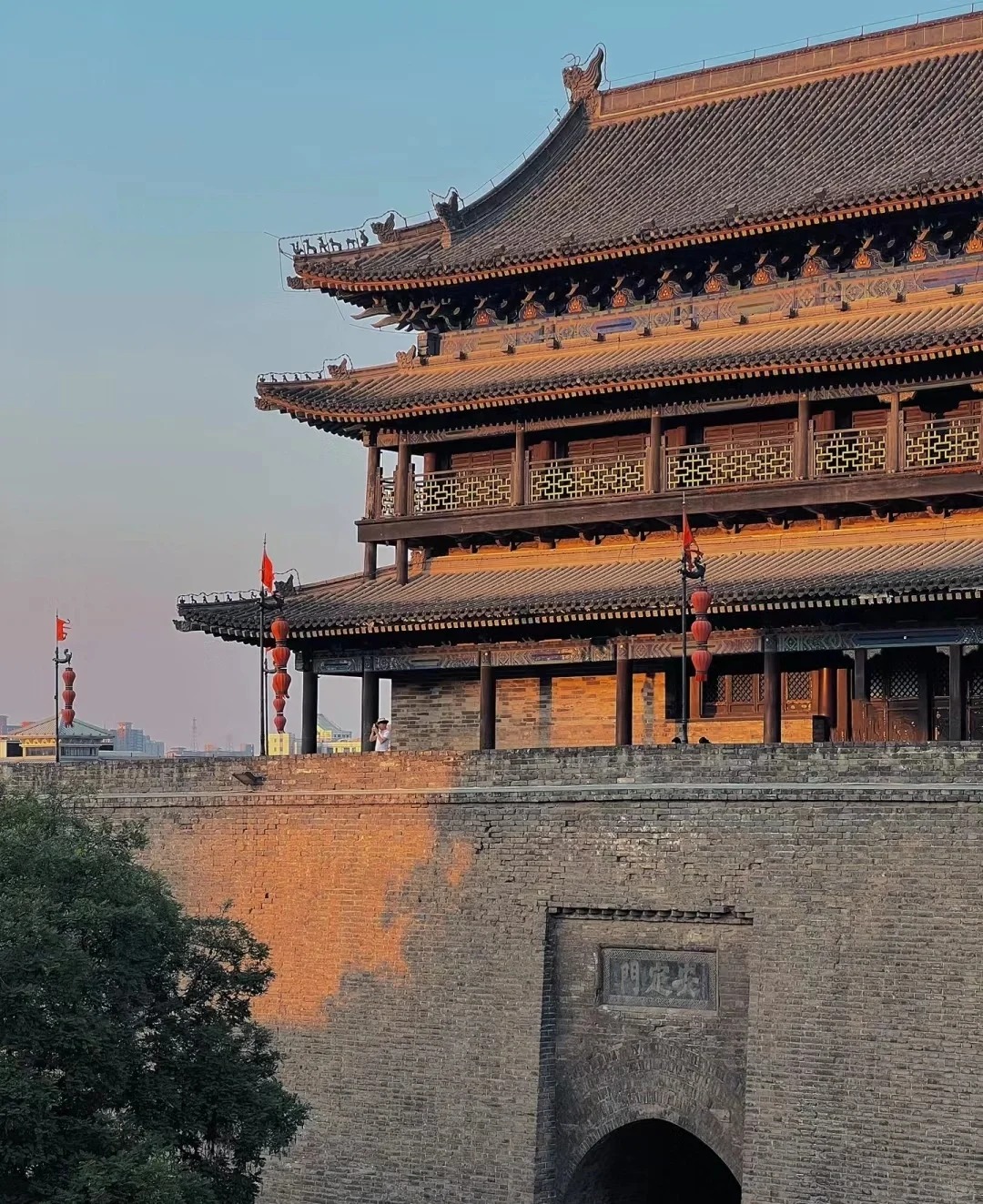
Photography Opportunities
- Panoramic City Views: The elevated position of the Xi’an City Wall offers unparalleled panoramic views of both the old and new parts of Xi’an. Photographers can capture stunning cityscapes that contrast ancient architecture with modern skyscrapers. The South Gate area, with its traditional Chinese gateway and bustling square, is particularly photogenic. Early morning or late afternoon light can create dramatic shadows and highlights across the urban landscape.
- Architectural Details: The wall itself provides numerous opportunities for close-up photography of its architectural features. The weathered bricks, ornate carvings on the gates and towers, and the texture of the ancient ramparts all make for compelling subjects. Photographers can focus on capturing the intricate details that showcase the wall’s age and craftsmanship, telling the story of its long history through images.
- Night Photography: After dark, the Xi’an City Wall is beautifully illuminated, creating a magical atmosphere. The lit-up gates and towers reflect in the moat, offering excellent opportunities for night photography. Long exposure shots can capture the movement of traffic around the wall, contrasting the ancient structure with the energy of the modern city. The wall also provides a unique vantage point for photographing the illuminated cityscape of Xi’an at night.
- Cultural Activities and Events: Throughout the year, various cultural events and reenactments take place on or around the City Wall. These include traditional performances, lantern festivals, and historical demonstrations. These events provide colorful and dynamic subjects for photography, capturing the living culture and traditions that the wall continues to support. Photographers can document these activities to showcase the wall’s ongoing role in Xi’an’s cultural life.
Modern Importance
- Urban Planning and Development: The Xi’an City Wall plays a crucial role in modern urban planning and development. It serves as a physical boundary that helps preserve the historical layout of the old city while allowing for modern development outside its perimeter. This unique urban structure has influenced Xi’an’s development patterns, encouraging a balance between heritage preservation and urban growth. The wall’s presence has also contributed to Xi’an’s distinctive cityscape, making it a model for integrating historical monuments into contemporary urban environments.
- Tourism and Economic Impact: As one of Xi’an’s most prominent attractions, the City Wall significantly contributes to the local tourism industry. It draws millions of visitors annually, both domestic and international, generating substantial revenue for the city. The wall’s popularity has spurred the development of related tourism infrastructure and services, creating jobs and boosting the local economy. Moreover, the wall’s status as a major tourist draw has helped position Xi’an as a key destination on China’s tourism map, enhancing the city’s global profile.
- Cultural Education and Heritage Preservation: The Xi’an City Wall serves as an open-air museum and educational resource, offering visitors and locals alike a tangible connection to China’s history. It plays a vital role in cultural education, helping to preserve and promote understanding of traditional Chinese architecture, military strategy, and urban planning. The ongoing preservation and restoration efforts on the wall demonstrate China’s commitment to protecting its cultural heritage, setting an example for heritage conservation practices nationwide.
- Public Space and Community Engagement: In modern times, the City Wall has been repurposed as an important public space for Xi’an’s residents. The wall-top walkway serves as a unique urban park, offering space for exercise, leisure activities, and community events. Regular cultural performances, art exhibitions, and festivals held on or around the wall foster community engagement and help maintain the structure’s relevance in contemporary society. This adaptive reuse of historical infrastructure demonstrates how ancient monuments can continue to serve important social functions in modern cities.

FAQ
- What is the Xi’an City Wall famous for?
The Xi’an City Wall is famous for being one of the oldest, largest, and best-preserved ancient city walls in China. It’s known for its impressive size, complete enclosure of the old city, and its well-maintained condition that allows visitors to walk or cycle its entire length. - What’s inside the Xi’an City Wall?
Inside the Xi’an City Wall is the old city of Xi’an, which includes many historical and cultural sites such as the Bell Tower, Drum Tower, Muslim Quarter, and numerous temples and museums. The area within the wall is a blend of ancient architecture and modern urban development. - Is the Xi’an City Wall free?
No, the Xi’an City Wall is not free. There is an entrance fee of 54 CNY for adults and 27 CNY for students and seniors (with valid ID). This fee allows access to walk or cycle on the wall. - Is the Xi’an City Wall worth visiting?
Yes, the Xi’an City Wall is definitely worth visiting. It offers a unique perspective on Chinese history and architecture, provides panoramic views of the city, and allows visitors to experience an important piece of China’s cultural heritage. - What to do in the Xi’an City Wall?
At the Xi’an City Wall, you can:
1. Walk or cycle around the entire 13.7 km circumference
2. Visit the gate towers and explore their exhibitions
3. Enjoy panoramic views of Xi’an city
4. Take photos of the ancient architecture
5. Participate in cultural events or performances held on the wall
6. Rent costumes for unique photo opportunities
7. Visit the City Wall Park at the foot of the wall - How do I get to the Xi’an City Wall in the local city?
In Xi’an, you can reach the City Wall by:
1. Metro: Take Line 2 to Yongningmen Station for the South Gate
2. Bus: Several lines stop at the South Gate, including 6, 11, 12, 23, 201, 206, 208, 216, 218, 221, 222, 229, 251, 300, 600, 604, 611, K630
3. Taxi: Ask to go to “Xi’an Chengqiang” or show the Chinese characters 西安城墙
4. Walking: The wall is centrally located and easily accessible on foot from many downtown locations - How to visit the Xi’an City Wall?
To visit the Xi’an City Wall:
1. Choose an entry point (South Gate is the most popular)
2. Purchase tickets at the entrance
3. Decide whether to walk or rent a bicycle (available at the entrance)
4. Allow 2-3 hours for a complete circuit of the wall
5. Visit in the morning for cooler temperatures or in the evening for night views
6. Wear comfortable shoes and bring water, especially in summer
7. Consider joining a guided tour for historical insights
8. Check for any special events or performances happening during your visit


